Today, the Department of Water Resources urged people to avoid physical contact with water at Pyramid Lake in Los Angeles County until further notice due to the presence of blue-green algae.
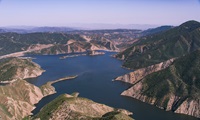
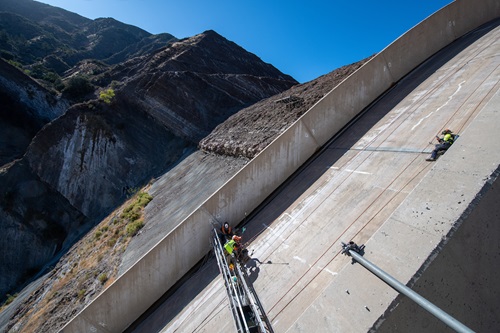
Crews install piezometers on the gated spillway for the Pyramid Dam Modernization project in Los Angeles County, California. DWR/2019
Pyramid Dam and Lake are located about 60 miles northwest of downtown Los Angeles and provides water storage for the greater Los Angeles area. The dam was built between 1969 and 1973 as part of the California Department of Water Resources (DWR) State Water Project (SWP).
DWR is modernizing its SWP portfolio across the state. This includes identifying and proactively addressing any issues that could impact the delivery of water or the safety of surrounding communities. Over the next several years, DWR will conduct assessments of Pyramid Dam and undertake measures to ensure the dam continues to function safely.
In its most recent condition assessment, the California Division of Safety of Dams (DSOD) rated Pyramid Dam as Fair – meaning there are no existing dam safety deficiencies recognized for normal operating conditions. However, rare or extreme hydrologic and/or seismic events may result in a dam safety deficiency. Interim or permanent risk reduction measures may be under consideration. In the case of Pyramid Dam, the rating of Fair is due to the concern over performance of the unlined emergency spillway during an extreme flood. The emergency spillway has never experienced water flow, as DWR has successfully managed reservoir levels over the years and released flood inflows through the low-level outlet and the gated spillway. An example of an interim measure that DWR continues to implement is operating the reservoir at a lower level during the winter to reduce the risk associated with large spillway releases.
Based on the most recent DSOD findings as well as other inspection and assessment activities conducted by DWR’s Division of Operations and Maintenance, the initial focus of the Pyramid Dam Modernization Program has been to assess the impacts of an extreme weather event on the gated spillway and the emergency spillway.
DWR, the owner and operator of Pyramid Dam in Los Angeles County, developed a public information toolkit to provide resources on dam safety and the Pyramid Dam Modernization Program.
The toolkit’s components include:
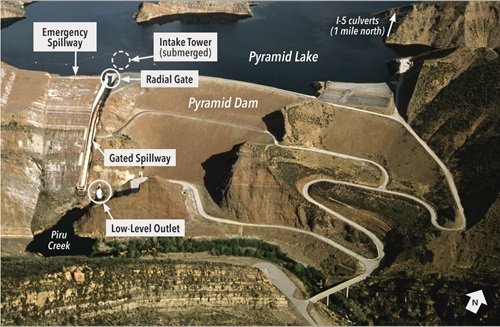

Today, the Department of Water Resources urged people to avoid physical contact with water at Pyramid Lake in Los Angeles County until further notice due to the presence of blue-green algae.
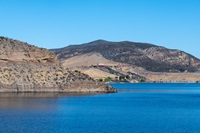
Pyramid Lake and Los Alamos Campground in Los Angeles County reopen Sept. 23 to the public following a temporary closure per a United States Forest Service order to ensure public safety due to widespread wildfires in California. Due to the presence of harmful blue-green algae at Pyramid Lake, the Department of Water Resources urges everyone to avoi ...
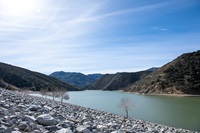
DWR is urging the public to avoid contact with water at Pyramid Lake in Los Angeles County until further notice due to blue-green algae (cyanobacteria).
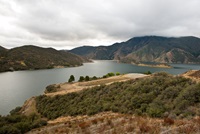
Today, the Department of Water Resources (DWR) announced that campgrounds at Pyramid Lake in Los Angeles County, Silverwood Lake in San Bernardino County and Lake Perris in Riverside County have reopened. In order to follow Department of Public Health guidelines, the campgrounds will be available at half capacity to allow for physical distancing.
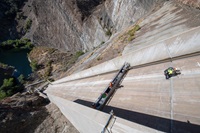
As part of an effort to modernize Pyramid Dam located in Los Angeles County, the Department of Water Resources (DWR) recently completed assessments for the dam’s gated and emergency spillways.

DWR is reopening recreational opportunities at Pyramid Lake in Los Angeles County on Saturday, May 23, 2020. Visitors are advised to follow CA Department of Public Health Guidelines, as well as Los Angeles County guidelines, to ensure the health and safety of employees and visitors.
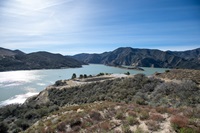
Following the guidance of the United States Forest Service, the California Department of Water Resources has temporarily closed Pyramid Lake in Los Angeles County to slow the spread of COVID-19.
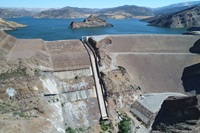
DWR is beginning assessment work on Pyramid Dam’s spillways in Los Angeles County as part of a statewide effort to reduce seismic and hydrologic risk to State Water Project (SWP) facilities spanning 705 miles throughout California.